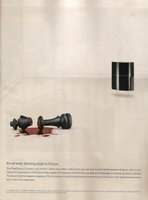Don’t you love it when something useful just falls into your lap? This happened to me yesterday. I got my issue of Entertainment Weekly (a week late…) and inside of it was this ad for the new Sony Playstation3.
It shows the new Playstation in the background, and in the foreground there is a bishop piece from a game of chess that is decapitated and bloody. Under this piece’s ‘corpse’ is the ad-line ‘It’s already devising ways to kill you’. I think this ad is a bit much. I also think that it is for reasons like this that the term moral panic exists. I think that there is something extreme in decapitating a game piece that is traditionally not associated with violence. What this alludes to in terms of gaming, is that everything must be violent in order to sell and be amusing. This makes me think of what Henry Jenkins said in his article Lessons from Littleton: What Congress doesn’t want to hear About Youth and Media. He states that “teens aren’t drawn to [video games] because they are bloodthirsty or because they think violence is the best real-world response to their problems” (391), but this is apparently untrue according to the advertising executives at Sony. Apparently violence should be what you think of in order to win. I mean, you have to be ultraviolent in order to beat this new Playstation3, it’s programmed to kill you (in the gaming sense), and so you’d best be prepared. This ad also seems to bring an attack on ideas of what is tough and what is cool. Chess is typically viewed as a game of intellect, and with the chess piece dead; this ad can be seen as an attack on intellect for the sake of cool. Also, note that the chess piece is a Bishop, the chess piece with the most obvious religious connotation. The bishop has been beheaded in a visually appealing sleek and stylized manner. Religion, like intellect, is also not traditionally viewed as cool and exciting, therefore it must be destroyed to allow for play and for coolness. Attacking two such dominant ideas of importance will inevitably create moral panic, as those who establish what is morally offensive are usually intellects or religious officials. The consumers and appreciators of media that is deemed ‘morally inappropriate’ are the ones who enjoy the sexist and violent aspects that are evident. Therefore, this advertisement caters to them, and celebrates fun through violence. It seems that this ad clashes with Jenkins’ theory as it presents violence as the ‘best real-world response’ (91) to religious and intellectual ideologies. Check moral panic...



No comments:
Post a Comment